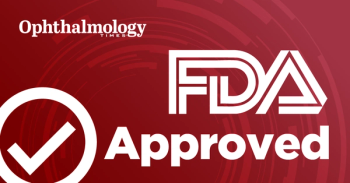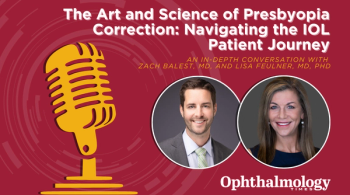
- Ophthalmology Times: September/October 2025
- Volume 50
- Issue 5
Periorbital rejuvenation: Past, present, and next
Key Takeaways
- Modern blepharoplasty focuses on preservation and repositioning of orbital fat, addressing volume loss and ligamentous laxity for natural results.
- Fat grafting and dermal fillers provide restorative approaches, while polynucleotides and exosomes enhance periorbital skin quality.
Innovations in surgery, biologics, and AI are shaping the future of eye aesthetics.
The aesthetic treatment of the periorbital region has evolved significantly, shaped by centuries of innovation and driven by the desire to understand anatomy and how it is affected by aging. Among the earliest documented advancements in eyelid surgery are the writings found in Tadhkirat al-Kahhalin by Ali ibn Isa of Baghdad around AD 940-1010, which included descriptions of upper eyelid blepharoplasty for conditions such as trichiasis and ptosis.1 His contemporary, Albucasis, expanded these surgical approaches with techniques such as crescent-shaped cauterization to correct eyelid ptosis.1
Blepharoplasty has transformed from a reconstructive necessity into a refined aesthetic procedure, incorporating advanced techniques including orbital fat repositioning and removal, meticulous skin excision, novel forms of volume restoration, and a focus on periocular skin quality. Eyelid surgery has evolved to meet modern demands for beauty without compromising a natural appearance and facial balance. Although modern techniques have dramatically enhanced the ability to rejuvenate the periorbital area, the aging process of the undereye region remains a topic that has not yet been conquered. Many pivotal innovations and discoveries have redefined the approach to treatment of the periorbital region, shifting the focus from aggressive intervention to conservative enhancement, and from overt correction to subtle, anatomy-informed rejuvenation.
Understanding periorbital aging
Recent discoveries in the dynamics of periorbital aging have further revolutionized treatment methods. Age-related changes are now recognized not simply as superficial laxity, but as a multilayered, dynamic process involving structural, volumetric, and biomechanical shifts. Superficial fat loss and anterior prolapse of the deep fat behind the orbital septum and skin laxity become more prominent with age.2 Loss of subcutaneous fat and thinning of the epidermis over the orbital rim, paired with the descent of the cheek, can result in a hollowed tear trough. As the skin elasticity diminishes, the prominence of malar mounds, edematous, sponge-like collections along the infraorbital region, can evolve into well-defined festoons.
Additionally, with the age-associated loss of muscle mass, the orbicularis oculi muscle undergoes changes that can compromise the aesthetic appearance and the function, leading to issues such as lagophthalmos and disruption in tear film balance.3 Bone also experiences degeneration with age, as seen in the resorption of the orbital bone, the remodeling of the inferior and superior orbital rim, and the increase in width of the orbital aperture.4 Lastly, with aging, the facial-retaining ligaments, including the orbicularis-retaining ligament and the tear trough ligament, atrophy and attenuate.4 These layered changes require a nuanced and meticulous approach to rejuvenation, incorporating restoration of volume, repositioning of soft tissue, and support of lymphatic and vascular integrity.
Modern blepharoplasty: preservation over excision
Blepharoplasty remains a foundational procedure in periorbital rejuvenation, offering both functional and aesthetic benefits when carefully selected. Traditionally, blepharoplasty was performed with a subtractive mindset: removing excess skin, muscle, and fat to “tighten” the eyelid area. However, improved understanding of periorbital aging has revealed that volume loss, fat descent, ligamentous laxity, and bony remodeling all contribute to the aged appearance. As a result, modern blepharoplasty techniques now emphasize preservation and repositioning of orbital fat rather than excision, particularly in the lower eyelid, to avoid a hollowed or gaunt look. The suborbicularis oculi fat lift technique and arcus marginalis release, along with fat grafting, allow fat to be preserved while producing a youthful, natural appearance.5
Additionally, procedures such as canthopexy and canthoplasty, which are often employed during lower blepharoplasty, reinforce lateral eyelid support and can treat a drooping eye appearance.6 As with any surgical procedure, blepharoplasty comes with risks, including dry eye syndrome, corneal abrasion, lid asymmetry, lagophthalmos, lacrimal gland injury, canthal webbing, postoperative hemorrhage, diplopia or infection, blepharoptosis, wound dehiscence, scleral show, and ectropion.7 Modern aesthetic strategies have evolved to include surgical refinements like fat grafting and a range of innovative nonsurgical interventions aimed at restoration, such as laser treatments to treat aging and dry eyes.
Fat grafting has become an increasingly valuable tool in periorbital rejuvenation because it offers an autologous, restorative approach that targets the underlying volume loss contributing to tear trough hollowing and orbital aging. Macrofat and microfat are typically used to restore structural volume to a hollow area,8 while nanofat is one of the richest sources of adipose-derived stem cells,9 making it ideal for improving skin texture and quality in the thin periorbital dermis. Microfat is typically used for periorbital treatment, as it minimizes the risk of nodule formation and complications, unlike macrofat.8 Nanofat is helpful for angiogenesis, immunomodulation, and wound healing.10
Fat grafting is not without risk. Improper placement, overfilling, or fat embolism can lead to contour irregularities, lumpiness, or more serious vascular complications, particularly given the highly vascular and delicate anatomy of the orbital region. Careful particle size selection and blunt cannula techniques are essential to minimize these risks and achieve a smooth, natural result.
For patients seeking less-invasive options with shorter recovery times, dermal fillers remain a popular alternative, offering immediate volume restoration and contour enhancement in the infraorbital region. Hyaluronic acid (HA) fillers are most commonly used due to their reversibility and ability to integrate well with periorbital tissues. However, this area’s thin, translucent skin presents unique challenges, including the risk of the Tyndall effect, contour irregularities, and swelling from lymphatic disruption. Product selection, injection depth, and proper injection technique are critical. Using a low G’ HA filler injected periosteally beneath the orbicularis oculi, while moderately undercorrecting the undereye, allows the filler to settle properly and integrate with the product. Either a cannula or a needle can be used for injection. However, while some may achieve more precise filler injection with a needle, there is a higher chance of bruising and vascular occlusion with a needle vs a cannula.11,12 Additionally, MRI studies have shown that HA fillers can last for years, contrasting with the traditionally regarded duration of 3 to 12 months.13,14 This long duration can lead to overfilling or filler migration. Overinjected filler or filler migration can be diagnosed with a simple visual assessment, a skin pinch test, or an ultrasound if unable to perform an MRI.
Although safe in experienced hands, dermal fillers carry serious complications, highlighting the importance of anatomical knowledge, precision, and a toolkit to correctly treat complications and dissolve the product when necessary. When performed thoughtfully, filler treatment can yield subtle, rejuvenating results that complement or even delay the need for surgical intervention. Skin quality plays an equally critical role in achieving optimal periorbital outcomes. Even with precise volume restoration, thin, crepey, or photodamaged skin can limit the aesthetic potential of any treatment. As a result, there is a growing emphasis on combining volumetric correction with modalities that treat the dermal skin quality.
Polynucleotides have become one of the most used regenerative agents for improving periocular skin quality. Sources from purified DNA fragments from Oncorhynchus mykiss (salmon trout) or Oncorhynchus keta (chum salmon) sperm cells,15 polynucleotides, or specifically polydeoxyribonucleotide (PDRN), have shown the ability to stimulate human skin fibroblast growth and support tissue repair.16 Studies have also demonstrated that PDRN can enhance angiogenesis, cellular activity, collagen synthesis, soft tissue regeneration, skin priming, and revitalization, and can be used to treat hyperpigmentation.17 Additionally, pre- and postoperative skin priming can reduce recovery time and improve outcomes.
Another innovative modality that has regenerative capabilities is exosomes. Exosomes are nanosized vesicles, secreted by stem cells, that contain growth factors, cytokines, proteins, lipids, and microRNA that facilitate intercellular communication and skin regeneration. They can promote collagen synthesis, reduce oxidative stress, and enhance wound healing, which can be especially beneficial for rejuvenating the delicate undereye skin.18 These treatments are typically introduced into the skin through microneedling, a minimally invasive technique that uses fine needles to create controlled microchannels in the epidermis and dermis, allowing the product to penetrate.
Laser technology is another powerful tool for improving skin. Ablative options such as fractional CO2 and erbium lasers can significantly help with skin texture, reduce fine lines, and tighten laxity by stimulating deep collagen remodeling. Although these procedures typically involve some downtime, many patients are willing to accept this in exchange for nonsurgical yet long-lasting results. Complementing lasers, radiofrequency microneedling devices have gained widespread popularity for their ability to deliver controlled thermal energy into the dermis, triggering neocollagenesis and neoangiogenesis, while preserving the integrity of the skin’s surface.19
The future: AI and regenerative medicine
The future of treating the periorbital region lies at the intersection of precision medicine, regenerative biology, and advanced artificial intelligence (AI) technology. Targeted gene therapy holds the potential to correct age-related disease by modulating specific genes. Senolytic drugs have been used to prevent cell senescence by clearing the damaged, aged cells that contribute to tissue dysfunction and aging.20 Rapamycin, a drug that decreases senescence, has been shown to extend the lifespan and health span of mice and other species.21,22
The potential applications of this field span various fields of medicine, including ophthalmology, where targeting cellular senescence may help preserve tissue function, delay age-related degeneration, and enhance overall regenerative outcomes. In ophthalmology, AI is already revolutionizing intraocular lens calculations with unmatched precision, and this same level of machine learning is beginning to influence aesthetic diagnostics, enabling real-time facial mapping, predictive outcome modeling, and individualized treatment planning. Advanced formulas such as the Kane, PEARL-DGS, Hill-RBF, and Nallasamy utilize machine learning and deep learning algorithms trained on large-scale biometric datasets to predict postoperative refractive outcomes more accurately .23
Robotic-assisted surgery is also on the horizon, with robots assisting in cataract surgery, retinal surgery, subretinal injections, retinal endovascular surgery, and intraoperative guidance.24
As AI and regenerative medicine continue to evolve, they are paving the way for a new era of aesthetic and ophthalmic care in which interventions are highly efficient, safe, and personalized, transforming the treatment approach to aging of the eye.
Kay Durairaj, MD, FACS
Durairaj is in private practice in Pasadena, California, and is vice chair of the Department of Head and Neck Surgery at Huntington Hospital. She specializes in nonsurgical rhinoplasty, collagen biostimulators, facial contouring, and advanced longevity therapies.
Julie Anush Kazaryan, BS
Kazaryan earned her bachelor’s degree in physiological sciences from the University of California, Los Angeles. She is interested in regenerative medicine and longevity science, and has worked closely with Durairaj on innovative, evidence-based approaches in integrative aesthetic medicine.
References
Espinoza GM, Holds JB. Evolution of eyelid surgery. Facial Plast Surg Clin North Am. 2005;13(4):505-v. doi:10.1016/j.fsc.2005.09.001
Naik MN. Hills and Valleys: Understanding the under-eye. J Cutan Aesthet Surg. 2016;9(2):61-64. doi:10.4103/0974-2077.184048
Krajewska-Węglewicz L, Felczak P, Dorobek M. Effects of aging on orbicularis oculi muscle strength and ultrastructure in dermatochalasis: a pilot study. J Clin Med. 2024;14(1):162. doi:10.3390/jcm14010162
Guo L, Song B. Enhancing aesthetic outcomes: the role of biomechanics in periorbital and eyelid cosmetic surgery. Indian J Ophthalmol. 2024;72(10):1424-1432. doi:10.4103/IJO.IJO_1549_23
Hoenig JA. Eyelid surgery – variations and techniques. Jonathan Hoenig, MD. Accessed July 30, 2025. https://drhoenig.com/eyelid-surgery-variations-and-techniques/
Frankeny A. Focus on the eyes: the ins and outs of canthopexy and canthoplasty. American Society of Plastic Surgeons. July 18, 2024. Accessed July 30, 2025. https://www.plasticsurgery.org/news/articles/focus-on-the-eyes-the-ins-and-outs-of-canthopexy-and-canthoplasty
Miotti G, Zeppieri M, Pederzani G, Salati C, Parodi PC. Modern blepharoplasty: from bench to bedside. World J Clin Cases. 2023;11(8):1719-1729. doi:10.12998/wjcc.v11.i8.1719
Strong AL, Rohrich RJ, Tonnard PL, Vargo JD, Cederna PS. Technical precision with autologous fat grafting for facial rejuvenation: a review of the evolving science. Plast Reconstr Surg. 2024;153(2):360-377. doi:10.1097/PRS.0000000000010643
Jeyaraman M, Muthu S, Sharma S, Ganta C, Ranjan R, Jha SK. 9. Nanofat: a therapeutic paradigm in regenerative medicine. World J Stem Cells. 2021;13(11):1733-1746. doi:10.4252/wjsc.v13.i11.1733
Wang X, Deng M, Yu Z, et al. Cell-free fat extract accelerates diabetic wound healing in db/db mice. Am J Transl Res. 2020;12(8):4216-4227.
Spada J, Ravera K, Schneider C. Needle versus cannula to treat tear trough: a prospective study comparing both methods. Plast Reconstr Surg Glob Open. 2023;11(11):e5327. doi:10.1097/GOX.0000000000005327
Alam M, Kakar R, Dover JS, et al. Rates of vascular occlusion associated with using needles vs cannulas for filler injection. JAMA Dermatol. 2021;157(2):174-180. doi:10.1001/jamadermatol.2020.5102
Master M, Azizeddin A, Master V. Hyaluronic acid filler longevity in the mid-face: a review of 33 magnetic resonance imaging studies. Plast Reconstr Surg Glob Open. 2024;12(7):e5934. doi:10.1097/GOX.0000000000005934
Master M. Hyaluronic acid filler longevity and localization: magnetic resonance imaging evidence. Plast Reconstr Surg. 2021;147(1):50e-53e. doi:10.1097/PRS.0000000000007429
Squadrito F, Bitto A, Irrera N, et al. Pharmacological activity and clinical use of PDRN. Front Pharmacol. 2017;8:224. doi:10.3389/fphar.2017.00224
Thellung S, Florio T, Maragliano A, Cattarini G, Schettini G. Polydeoxyribonucleotides enhance the proliferation of human skin fibroblasts: involvement of A2 purinergic receptor subtypes. Life Sci. 1999;64(18):1661-1674. doi:10.1016/s0024-3205(99)00104-6
Khan A, Wang G, Zhou F, et al. Polydeoxyribonucleotide: a promising skin anti-aging agent. Chin J Plast Reconstr Surg. 2022;4(4):187-193. doi:10.1016/j.cjprs.2022.09.015
Bin Dayel S, Hussein RS. Exosomes in dermatology: emerging roles in skin health and disease. Pharmaceutics. 2025;17(5):600. doi:10.3390/pharmaceutics17050600
Meyer PF, de Oliveira P, Silva FKBA, et al. Radiofrequency treatment induces fibroblast growth factor 2 expression and subsequently promotes neocollagenesis and neoangiogenesis in the skin tissue. Lasers Med Sci. 2017;32(8):1727-1736. doi:10.1007/s10103-017-2238-2
Kitaeva KV, Solovyeva VV, Blatt NL, Rizvanov AA. Eternal youth: a comprehensive exploration of gene, cellular, and pharmacological anti-aging strategies. Int J Mol Sci. 2024;25(1):643. doi:10.3390/ijms25010643
Sheppard AJ, Delgado K, Barfield AM, et al. Rapamycin inhibits senescence and improves immunomodulatory function of mesenchymal stem cells through IL-8 and TGF-β signaling. Stem Cell Rev Rep. 2024;20(3):816-826. doi:10.1007/s12015-024-10682-x
Harrison DE, Strong R, Sharp ZD, et al. Rapamycin fed late in life extends lifespan in genetically heterogeneous mice. Nature. 2009;460(7253):392-395. doi:10.1038/nature08221
Stopyra W, Cooke DL, Grzybowski A. A review of intraocular lens power calculation formulas based on artificial intelligence. J Clin Med. 2024;13(2):498. doi:10.3390/jcm13020498
Nuliqiman M, Xu M, Sun Y, et al. Artificial intelligence in ophthalmic surgery: current applications and expectations. Clin Ophthalmol. 2023;17:3499-3511. doi:10.2147/OPTH.S438127
Articles in this issue
about 1 month ago
Transformative advances in vision research: It’s the scienceabout 1 month ago
Anti-VEGF innovations in retinal disease: From molecules to medicineabout 1 month ago
From numbers to meaning: Graphical reporting in refractive surgeryabout 1 month ago
Evolving glaucoma therapy: A new era of interventional strategiesabout 1 month ago
Proactive strategies and sustained delivery advance glaucoma careNewsletter
Don’t miss out—get Ophthalmology Times updates on the latest clinical advancements and expert interviews, straight to your inbox.


















































.png)


